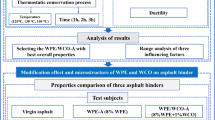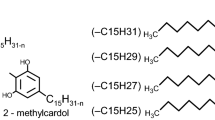Abstract
Eco-friendly alternative binders for asphalt were studied, utilizing green bio-additives (GBA) with different compositions. These GBA were prepared using the waste of cooking oil (WCO) in different ratios ranged from 10 to 40% from the whole composite; on the other hand, the waste polymer (WP), which formed from styrene–butadiene rubber (WSBR) and waste polystyrene (WPS) in a ratio ranged from 90 to 60% from the GBA composite, was used. The optimum composition of GBA has been chosen based on the physical and curing properties, which define that the [60% WP (WSBR and WPS separately) with 40% WCO] is the optimum composite. Asphalt 60/70 (A) and 80/100 (B) were used in this study, GBA with different ratios ranged from 10 to 50% from the applied asphalt were added to prepare green alternative binder (GAB), and physical and rheological properties before and after curing were investigated. The physical properties of the GAB including penetration, softening point, penetration index and penetration temperature susceptibility before and after curing were studied. Rheological properties of pure asphalt and the prepared GAB were studied using dynamic shear rheometer. Herein, data revealed that the GAB consisting of equal proportions between WCO and WP is simulated to original asphalt in the physical and rheological properties. The results showed that in case of asphalt 60/70, when using the 40% WSBR, the softening point increased by 17.7% and penetration decreased by 15.4%, and when using the 40% WPS, the softening point increased by 24.4% and penetration decreased by 16.9%. In case of 50% GAB, when using asphalt 60/70 + 40% WPS, the softening point increased by 17.7%, while using asphalt 80/100 + 40% WPS the softening point increased by 28.9%. Additionally, these materials are a promising candidate to replacement the non-renewable asphalt binders which used in the construction of road infrastructure, with a healthy environment and reduce the cost of road construction.



























Similar content being viewed by others
Reference
Maharaj R, Ramjattan-Harry V, Mohamed N (2015) Rutting and fatigue cracking resistance of waste cooking oil modified trinidad asphaltic materials. Sci World J 2015:1–7
Kowalski KJ, Król J, Radziszewski P, Casado R, Blanco V, Pérez D, Wayman M (2016) Eco-friendly materials for a new concept of asphalt pavement. Transp Res Procedia 14:3582–3591
Sun D, Lu T, Xiao F, Zhu X, Sun G (2017) Formulation and aging resistance of modified bio-asphalt containing high percentage of waste cooking oil residues. J Clean Prod 161:1203–1214
Önal EP, Uzun BB, Pütün AE (2011) Steam pyrolysis of an industrial waste for bio-oil production. Fuel Process Technol 92(5):879–885
Xu Q, Lan P, Zhang B, Ren Z, Yan Y (2010) Hydrogen production via catalytic steam reforming of fast pyrolysis bio-oil in a fluidized-bed reactor. Energy Fuels 24(12):6456–6462
Fini EH, Al-Qadi IL, You Z, Zada B, Mills-Beale J (2012) Partial replacement of asphalt binder with bio-binder: characterisation and modification. Int J Pavement Eng 13(6):515–522
Xiujuan G, Shurong W, Qi W, Zuogang GUO, Zhongyang LUO (2011) Properties of bio-oil from fast pyrolysis of rice husk. Chin J Chem Eng 19(1):116–121
Yang, S. H., Suciptan, T., & Chang, Y. H. (2013). Investigation of rheological behavior of Japanese cedar based bio-binder as partial replacement for bituminous binder (No. 13-3801).
Mohammad LN, Elseifi MA, Cooper SB III, Challa H, Naidoo P (2013) Laboratory evaluation of asphalt mixtures that contain biobinder technologies. Transp Res Record 2371(1):58–65
Sun Z, Yi J, Huang Y, Feng D, Guo C (2016) Properties of asphalt binder modified by bio-oil derived from waste cooking oil. Constr Build Mater 102:496–504
Lei Z, Bahia H, Yi-qiu T (2015) Effect of bio-based and refined waste oil modifiers on low temperature performance of asphalt binders. Constr Build Mater 86:95–100
Gong M, Yang J, Zhang J, Zhu H, Tong T (2016) Physical–chemical properties of aged asphalt rejuvenated by bio-oil derived from biodiesel residue. Constr Build Mater 105:35–45
Yang X, Mills-Beale J, You Z (2017) Chemical characterization and oxidative aging of bio-asphalt and its compatibility with petroleum asphalt. J clean prod 142:1837–1847
Onochie, A., Fini, E., Yang, X., Mills-Beale, J., & You, Z. (2013). Rheological characterization of nano-particle based bio-modified binder. In Transportation Research Board 92nd Annual Meeting (pp. 125–131).
Fini, E. H., Oldham, D., Buabeng, F. S., & Nezhad, S. H. (2015). Investigating the aging susceptibility of bio-modified asphalts. In Airfield and Highway Pavements 2015 (pp. 62–73).
Fang KT, Lin DK, Winker P, Zhang Y (2000) Uniform design: theory and application. Technometrics 42(3):237–248
Raouf MA, Williams RC (2010) Rheology of fractionated cornstover bio-oil as a pavement material. Int J Pavements 9:58–69
Yang X, You Z, Mills-Beale J (2014) Asphalt binders blended with a high percentage of biobinders: aging mechanism using FTIR and rheology. J Mater Civil Eng 27(4):04014157
U. S. Environmental Protection Agency,(2011). https://www.epa.gov/region9/waste/biodiesel/ questions.html. Accessed July 10
Singhabhandhu A, Tezuka T (2010) The waste-to-energy framework for integrated multi-waste utilization: Waste cooking oil, waste lubricating oil, and waste plastics. Energy 35(6):2544–2551
Chen M, Leng B, Wu S, Sang Y (2014) Physical, chemical and rheological properties of waste edible vegetable oil rejuvenated asphalt binders. Constr Build mater 66:286–298
Al-Omari AA, Khedaywi TS, Khasawneh MA (2018) Laboratory characterization of asphalt binders modified with waste vegetable oil using SuperPave specifications. Int J Pavement Res Technol 11(1):68–76
Zargar M, Ahmadinia E, Asli H, Karim MR (2012) Investigation of the possibility of using waste cooking oil as a rejuvenating agent for aged bitumen. J Hazard Mater 233–234:254–258
Yaakob Z, Mohammad M, Alherbawi M, Alam Z, Sopian K (2013) Overview of the production of biodiesel from waste cooking oil. Renew sustain Energy Rev 18:184–193
Gui MM, Lee KT, Bhatia S (2008) Feasibility of edible oil versus non-edible oil versus waste edible oil as biodiesel feedstock. Energy 33(11):1646–1653
Bary EA, Farag RK, Ragab AA, Abdel-monem RM, Abo-shanab ZL, Saleh AMM (2020) Green asphalt construction with improved stability and dynamic mechanical properties. Polym Bull 77(4):1729–1747
Read J, Whiteoak D, Hunter RN (2003) The shell bitumen handbook. Thomas Telford
Yu J, Cong P, Wu S (2009) Laboratory investigation of the properties of asphalt modified with epoxy resin. J Appl Polymer Sci 113(6):3557–3563
Sukhlaaied W, Riyajan SA, Palmese GR (2016) Dynamic viscosity of maleate poly (vinyl alcohol) and its copolymer measured by rheometer. Polym Test 56:387–393
Moghaddam TB, Karim MR, Abdelaziz M (2011) A review on fatigue and rutting performance of asphalt mixes. Sci Res Essays 6(4):670–682
Author information
Authors and Affiliations
Corresponding author
Additional information
Publisher's Note
Springer Nature remains neutral with regard to jurisdictional claims in published maps and institutional affiliations.
Rights and permissions
About this article
Cite this article
Nassar, I.M., Abdel-monem, R.M., Sayed, M.A. et al. Eco-friendly green alternative binder for asphalt from waste oil and waste polymer. Polym. Bull. 78, 6887–6909 (2021). https://doi.org/10.1007/s00289-020-03463-2
Received:
Revised:
Accepted:
Published:
Issue Date:
DOI: https://doi.org/10.1007/s00289-020-03463-2




